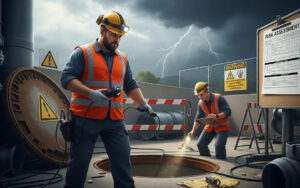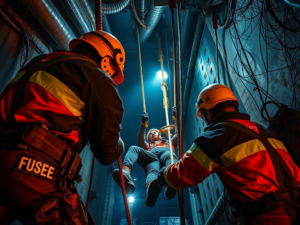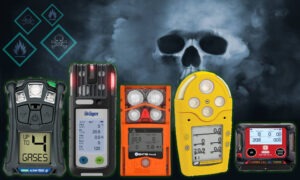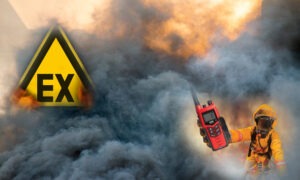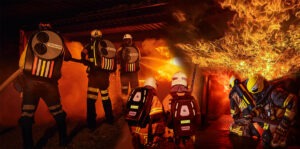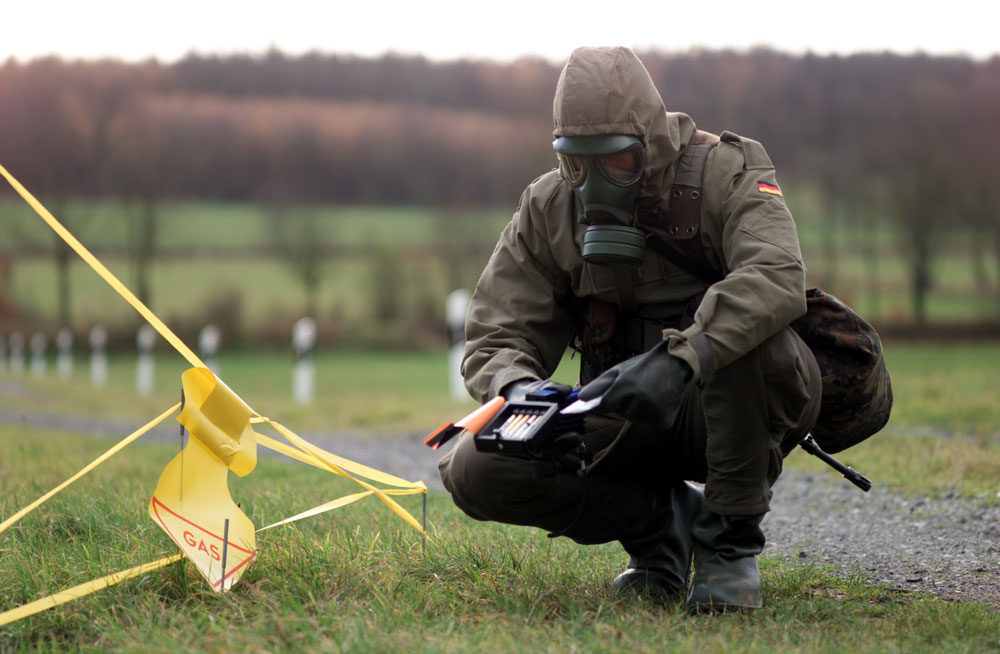
By John S. Retsios
Chemical Suits Donning & Doffing Procedures in Detail
(The previus article, Part I you can read here)
The following are instructions for donning and doffing of Type 3 & 4 chemicals suits to minimize the risk of contamination. These instructions can apply to any similar suit. Both donning and especially doffing is easier and safer if assisted by a colleague.
Note: Do not try to remove a garment contaminated with chemicals without assistance.
Donning 1.
- Remove the garment from its bag and unfold carefully, ideally on a smooth surface avoid rough surfaces that may scratch or damage the garment fabric.
- Careful open the outer zip flap by unfastening the Velcro, inserting a finger behind the top and sliding the finger down to the bottom. Fully unzip the outer and then the inner zip.
- In a sitting position remove shoes or boots. (Donning the coverall with boots on risks damaging the suit unnecessarily).
- Whilst sitting, open the garment and insert one leg after the other into the garment legs, carefully pulling the legs up over the feet. Once the legs are fully donned it is a good idea at this stage to replace shoes or boots.
- For garments with attached feet / boot flaps the attached feet should slide into the chemical boot. (a woolen sock pulled over the feet can assist and add comfort if required). The boot flap is pulled over the outside of the chemical boot.
- Stand and pull the garment up the body, placing each arm into a sleeve one after the other, and ensuring the garment is comfortably sitting on the shoulders.
- For garments with attached gloves ensure the hands are fitted into the gloves properly
- For garments with double cuffs: pull the outer sleeve back and seat the inner sleeve to the wrist; pull on the glove then pull the outer cuff over the gauntlet of the glove. This process will be much easier with assistance
- From this point it is better to have a colleague assist and perform the remainder of the procedure. Pull the inner zip up about three quarters by holding the bottom of the zip with one hand and sliding the zip up with the other. Take care not to trap fabric in the zip. Further adjust the garment if required.
- If a face mask is to be worn, don it now ensuring it is properly seated and comfortable. If an air supply is required as part of the mask switch it on or ensure breathing is normal if a filter mask is used.
- Carefully pull the hood over the head, seating the elasticated edge to any face mask as required. Pull the inner zip up to the neck. Ensure the zip is fully closed. Ensure the hood edge is seated properly against the face mask or face as required.
- Fold the inner flap into the flap housing and then slide the outer zip up carefully ensuring the inner flap folds back on itself and taking care not to trap the flap fabric in the zip. Slide the outer zip to the neck and ensure it is fully closed.
- To fasten the outer flap:
- For Velcro versions: carefully attach the Velcro at the neck first and gradually press together down the garment ensuring there are no folds or gaps left in the Velcro join.
- For adhesive tape versions: carefully remove the backing of the tape on the flap from the top by peeling it down carefully. Ensure the exposed tape does not become damaged or dirty. Fasten the tape at the top first by pulling the flap across the neck of the garment, then carefully press the tape into place all the way down, again ensuring there are no folds or creases.
- At this stage your colleague should again check to ensure zips are fully closed, and the outer flap is fully sealed with no gaps, creases, or holes.
- Once the suit is donned and seated properly, make any final adjustments, and conduct a further visual check to ensure the hood is suitably seated to face mask or face and that there are no tears or damages in the fabric or seams of the suit
- Finally, at this stage further sealing of the joins between parts of the PPE ensemble may be made – hood to facemask, sleeve to glove, ankle to boot. This can be done using a suitable chemical tape. Doffing chemical protective garments are designed to protect against splashes and sprays of chemicals. They are not intended for long term or extended exposure to chemicals and as such when contaminated during use should be removed as quickly as possible and disposed of accordingly.
Any contaminated suit must be removed with the help of a qualified assistant. The assistant should be wearing suitable PPE subject to the chemical contaminant such as gloves, coverall, face mask etc. The key task is to ensure that any chemical on the outside of the suit does not come into contact with the wearer or the assistant.

- Heavily contaminated suits should be de-contaminated first by the use of a suitable method such as a decontamination shower.
- The assistant should carefully remove the hood from the wearer, turning the hood inside out to prevent contamination contacting the wearers head. Any face mask can then be removed.
- The assistant should then open the outer zip flap to expose the outer zip and using the zip pull slide the zipper down to the bottom.
- The inner flap and zip can be opened in the same manner – ensuring the body of the garment is folded outwards and away from the wearer’s body in the process.
- With wearer standing with arms slightly back, the assistant then stands behind the wearer and pulls the cuff of the garment over the wearer’s hands. He can then gently slide the shoulders off the body of the wearer, the wearer withdrawing his arms at the same time, again, turning the sleeves and body inside out in the process.
- The body of the garment can then be removed back and down the legs of the wearer.
- With the wearer sitting, any boots should be removed, and the garment legs can be pulled over the wearer’s feet.
- The contaminated suit should be folded inside out and placed in a suitable bag for disposal garments are generally manufactured from polypropylene, polyethylene, or similar polymers.
There are no known hazards from incineration or from placement in landfill. Uncontaminated suits can therefore be disposed of in the normal manner depending on local laws and regulations.
However contaminated suits must be disposed of in a manner suitable given consideration of the chemical contaminant. This will depend on the chemical itself and on local legal requirements. Companies will normally have their own procedures for disposal of chemical contaminated equipment.
Chemical Suits Level A
Donning & Doffing Procedures in Detail
Good safety practices require an assistant to help you don and doff the suit. This is easier and quicker, and you will avoid stumbling or tripping which may result in personal injury or damage to the suit.
Follow these steps in putting on the suit:
- Make sure the suit has been visually inspected, air pressure tested and is free from defects. Also make sure the correct suit has been selected for the intended use.
- Underclothing should be worn under the chemical suit. As a minimum, a long sleeve shirt and long pants or “long underwear” are recommended.
- Remove all personal affects which might result in damage to the suit (e.g. pens, badges, jewelry, etc.).
- Remove shoes. Most boots don’t allow street shoes.
- Tuck pant cuff into socks to make donning of suit legs and sock boot easier.
- Using a SCBA (Self Contained Breathing Apparatus), check the level of air, complete all connections, make all adjustments in accordance with the manufacturer’s procedures. Do not put the face piece on, yet, unless required by the design of the SCBA.
- While seated place both legs into the suit. (Preferably start with right leg) Stand up and attach the internal waist belt. Belt is intended to help adjust the fit of the suit. In case there is a height adjustment system please adjust it accordingly.
- Turn on the air supply, put on facepiece, and make sure air supply system is working properly.
- Place your right arm and the head inside the suit, then the left arm, close the zipper, then Velcro shut the fly over the top of the zipper. (Be careful not stretching the zipper stop at the end, some manufacturers have very strict rules and instructions regarding this) Always leave about 20cm the zipper open to maintain communication with the user and when you are ready close tight and give a thump up. (Zipper close from bottom to the hood)
- The person assisting should check to make sure the zipper covers are completely closed, all airline connections are tight, and suit appears to be working properly.
Note: Do not try to remove a garment contaminated with chemicals without assistance.
Doffing Procedure
The person assisting in the doffing procedure should be wearing the appropriate attire selected by Qualified Safety Personnel. (It is suggested that the assistance must be fully trained in A type suits)
- The person assisting should open the zipper flaps by separating the velcro attached to the fly and open the zipper by pulling the zipper tab at the opening of the zipper.
- The user should pull their arms back into the body of the suit, remove their safety helmet, and hand safety helmet to the assistant (this will prevent the assistant from touching the inner suit with their gloves that may be wet or contaminated. (Pay attention to the zipper, handle with care)
- Carefully remove the head and arms from the suit.
- Loosen the air supply mask (allow the mask to hang around the neck until the air supply has been cut off. Remove the air system per the instructions provided with that particular system.
- Loosen the suit belt and allow suit to fall. Assume a sitting position for stability. The assistant should remove the outer boots and hold the bottom of each leg to allow the user to remove legs from the suit more easily.
PAPR = Powered Air Purifying Respirator
A powered, air-purifying respirator (PAPR) is a type of personal protective equipment used to safeguard workers against contaminated air. PAPRs consist of a respirator in the form of a hood, or full-face mask, which takes ambient air that is contaminated with one or more type of pollutant or pathogen, actively removes (filters) a sufficient proportion of these hazards, and then delivers the clean air to the user’s face and/or mouth. PAPRs are sometimes called positive-pressure masks, blower units, or just blowers.

How does a PAPR work?
-
- With a Mask & Filter combination the wearer has to “pursue” the air to pass the filter. This leads to an uncomfortable effect: Breathing resistance!
- A PAPR operates with a fan/blower unit which is powered by a battery. The blower unit pulls the air through the filter and blows it through an outlet
- In most cases the air outlet of the PAPR unit is connected to a headpiece by a hose
- The headpiece can be the same full-face mask like used for mask & filter combination, but due to the high airflow other headpieces like hoods, helmets, visors or welding visors are possible as well.
FFM = Full Face Masks or GM = Gas Masks
A full-face mask or a gas mask is a device designed to protect the wearer from noxious vapors, dust, and other pollutants. Masks may be designed to carry their own internal supply of fresh air, or they may be outfitted with a filter to screen out harmful contaminants. The latter type, known as an Air Purifying Respirator (APR), consists of a tight-fitting face piece that contains one or more filter cartridges, an exhalation valve, and transparent eye pieces.
The first APR was patented in 1914 by Garret Morgan of Cleveland, Ohio, an African American inventor also credited with major improvements in the traffic signal. When the Cleveland Waterworks exploded in 1916, Morgan showed the value of his invention by entering the gas-filled tunnel under Lake Erie to rescue workers. Morgan’s device later evolved into the gas mask, used in World War I to protect soldiers against chemicals used in warfare.
Since that early time, there have been significant advances in gas mask technology, particularly in the area of new filtration aids. In addition, masks have been made more comfortable and tighter fitting with modern plastics and silicone rubber compounds. Today APRs are used to filter many undesirable airborne substances, including toxic industrial fumes, vaporized paint, particulate pollution, and some gases used in chemical warfare.
These masks are produced in several styles, some that cover only the mouth and nose (half masks) and others that cover the entire face, including the eyes. They may be designed for military as well as industrial use but, even though the two types are similar in design, the military masks must meet different standards than those used in industry.
 | 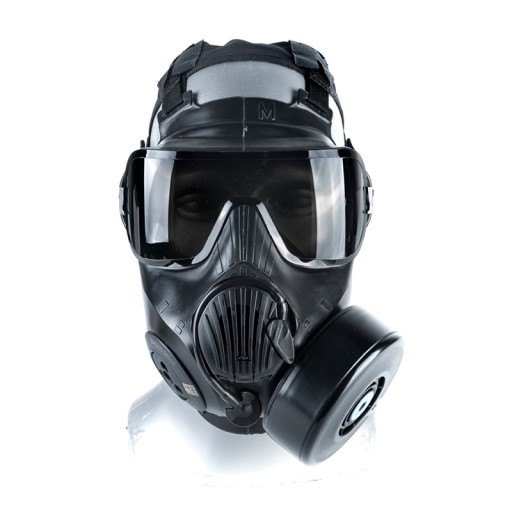 |
The gas mask usually utilizes two independent sealing edges, providing three sealing rings. The face mask must be available in 3 different sizes (S, M, L) or one size fits all usually that refers to M2 size (Medium mask, size no 2 inner mask)
Head harness can be directly applied to the sealing edges to minimize deformation of the seal and prevent leakage.
The visor of the full-face mask must have an effective field of vision based on a three-dimensional shape and designed in a way so that air from the cylinder passes over the mask lens prior to inhalation to prevent fogging on the inside of the visor.
It is optional but a good choice always to have the full-face mask with an anti-scratch coating.
Read here Part III: P.P.E. for HazMat operations and C.B.R.N.E. incidents, part III
*Mr. John Retsios is a professional trainer for HazMat and C.B.R.N.E. – P.P.E with an experience of more than 20 years in the field.
Bibliography
- Ahmstead, B.H. Manufacturing Processes. John Wiley and Sons, 1977
- How to choose the right PPE James P. Zeigler Ph.D.2007
- S. Department of Health and Human Services
- The National Personal Protective Technology Laboratory (NPPTL)
- DelValle Institute & Learning Center
- Grainger Institution for Safety
- Understanding EN and NFPA Standards for Chemical Protective Suits, Ian Hutcheson, 2012
- Protective clothing against chemical and biological hazards, Erja Mäkelä, Helena Mäkinen, Finnish Institute of Occupational Health
- Ansell S.
- Drägerwerk AG & Co. KGaA
- MSA the Safety Company
- Respirex International Ltd
- TESIMAX – Altinger GmbH
- DYNAT Verschlußtechnik GmbH
Acronyms
- CBRNE : Chemical Biological Radiological Nuclear and Explosive
- PAPR : Powered Air Purifying Respirator
- SCBA : Self-Contained Breathing Apparatus
- CCBA : Closed Circuit Breathing Apparatus
- LDV : Lund Demand Valve
- CPS : Chemical Protective Suit


